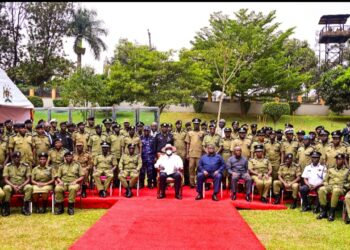KAMPALA – The government is in the final final stages of rolling out a new system for management of learners’s information in the country’s education institutions that will help the Ministry of Education and Sports track all in the system from from primary to university level.
The development, according to officials, is to be preceded by the deployment of the re-developed Education Management Information System (EMIS), which is being procured for the education sector through the Ministry of ICT and National Guidance under its National ICT Initiatives Support Program (NIISP) programme.
Officials from the Ministry of Education and that of ICT, on Wednesday 29th September, made representations at the Ministry of Finance, Planning & Economic Development, at a meeting chaired by the new Permanent Secretary Mr Ramathan Ggoobi.
According to proceedings of the meeting seen by this newspaper, Mr. David Mushabe, from SMSONE Ltd — the EMIS consultants, made a presentation, including a demo on how the EMIS software would work.The new ICT Ministry’s Permanent Secretary Dr. Aminah Zawedde attended the meeting.
Mr Moses Watasa, the commissioner for Information in ICT ministry, has hailed the EMIS as a major breakthrough the their effort by the government to entrench the use of ICTs in all education and other government institutions.
“As a ministry we strongly associate ourselves with automating government systems, and for the education sector it (EMIS) is going to support the planning, budgeting and projections because the figures and statistics will be readily available at the click of a button,” Mr Watasa said in an interview on Monday, October 4.
Mr Ggoobi, said in an interview on Sunday, October 3, that as the financier, the ministry is actively participating in developing EMIS and other related tools, such as TELA (Teacher Effectiveness and Learners Achievement) system to improve education quality in the country.
“The Ministry is going to finance the roll out of these systems as well as other digital platforms intended automate public services to achieve efficiency (lower cost of delivery), transparency and accountability. On these add eGP (electronic government procurement) that we are going to roll out after a successful pilot in particular entities,” Ggoobi said.
Mr Ggoobi is confident that the aforesaid efforts will minimize corruption and enhance service delivery, and noted that the ministry has also financed the roll out of the Health Management Information System (HMIS) as an Integrate Intelligent Computer System (IICS) that is going to trace government procured medicines and other health supplies from the National Medical Stores, to the patient as well as the attendance of healthcare workers.
Mr. Mushabe, the team leader for the developers said in an interview that his team is drawing on earlier success in implementing similar system in government institutions, for example the Uganda National Examinations Board (UNEB).
“This system was implemented in 2015 and currently process data of candidate classes in all primary and secondary schools. The total number of learners being managed per year is over 1.2 million,” Mr Mushabe said in an interview on October 3.
He disclosed that the UNEB system also provides user accounts to more than 15,000 schools including all local government users such DEOs and District Inspector of schools.
According to the information available, the EMIS tracker is expected to integrate all data and information about leaners in the education and sports sector make it available to various stakeholders at various levels of decision and data consumption for the effective planning, management and accountability.
According to the presentation by Mr. Mushabe, seen by our reporter, the redeveloped EMIS is supposed to address the challenges faced by the Education Ministry during the EMIS data collection, processing and analysis.
It is understood that the old EMIS tracker used the school census approach where hardcopy questionnaires were distributed to schools. However, this approach posed several challenges such as inflation of number of learners by school head teachers.
Officials say, that the old EMIS software was supplied by donors and when the project ended, there was no support in place to maintain the system, and it eventually collapsed. According to Mr Mushabe’s presentation, the old system has not been updated in very long time and there is no source code in place or user manuals which would be helpful in upgrading the system.
Therefore, the new EMIS software, which will cover information management from pre-primary, primary and secondary schools including tertiary and non-tertiary institutions, will be online-based and accessible to all stakeholders including District Education Officers, School Inspectors, Chief Administrative Officers and Resident District Commissioners.
Mr Mushabe’s presentation presented an intuitive web portal which schools will access to create their EMIS user accounts and to update data about their learners, teaching and non-teaching staff, infrastructure and facilities including physical education and sports.
Two of the peculiar features of EMIS as seen in the presentation are the introduction of unique learner identification number (LIN) and the functionality to track how learners will transfer from one school to another.
The LIN, automatically generated by EMIS, will work as the unique identifier until all learners have been issued the National Identification Number (NIN) by NIRA. Each LIN will be linked to the NIN of the learner’s parent or guardian. In any case, the LIN will be a mandatory requirement for UNEB registration, and a learner will use same LIN from pre-primary to University.
Further, to avoid double counting of learners or learner inflation, schools will not be permitted to receive and register learners in EMIS without first submitting learner transfer requests into EMIS. According to sources familiar with EMIS at Education Ministry, the use of LIN and the learner transfer features in EMIS are expected to weed out ghost learners.
For new schools wishing to submit applications for either EMIS number, license or registration certificate for their institutions, will do so in EMIS. Previously, these processes have been manual and taking a lot of time to accomplish. With the new EMIS, both the application and renewal processes shall be handled online.
Once fully implemented, the new EMIS will be handling records of close to 15 million learners from over 48,000 education institutions across Uganda. There are reportedly high expectations by Education Ministry top management, and therefore the success of EMIS completion will be a key legacy project for the current leadership. The expected rollout of the system is said to be dependent on the re-opening of schools, which is basically next year.
Despite the interesting features of the new EMIS for the education sector, there are some worries about the issues of system accessibility since most schools lack internet connectivity and computers. This is indeed acknowledged by the Education Ministry, however, with the Finance Ministry get heavily involved in the implementation and rollout of EMIS, there is possibility of raising funds to facilitate some schools and local governments in acquiring gadgets to use for EMIS activities. For internet connectivity, the new EMIS will support an offline mode implying that schools can use the software to register learners and export the data to be uploaded online in places where they can access internet. Our investigations have revealed that institutions like UNEB and other tertiary institutions are already offering all their services online. This implies that somehow schools will improvise ways to have their learners registered in EMIS once rolled out.
Mr. David Ssengendo, Headmaster Buganda Road Primary School said; “We are excited by the impending roll of the revamped EMIS. We have not yet gotten the official brief about it but I am aware of this positive development for our sector because we should be able to trace dropout rates. It is also a big addition to have a feature tracking teacher attendance and movements from one school to another. That’s certainly good tool to weed out teachers dodging work”.
Do you have a story in your community or an opinion to share with us: Email us at editorial@watchdoguganda.com













